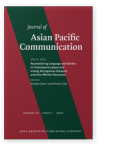Introduction published In:
Reconsidering Language and Gender in Contemporary Japan and among the Japanese Diaspora amid the #MeToo MovementEdited by Kikuko Omori and Hiroshi Ota
[Journal of Asian Pacific Communication 33:1] 2023
► pp. 1–11
